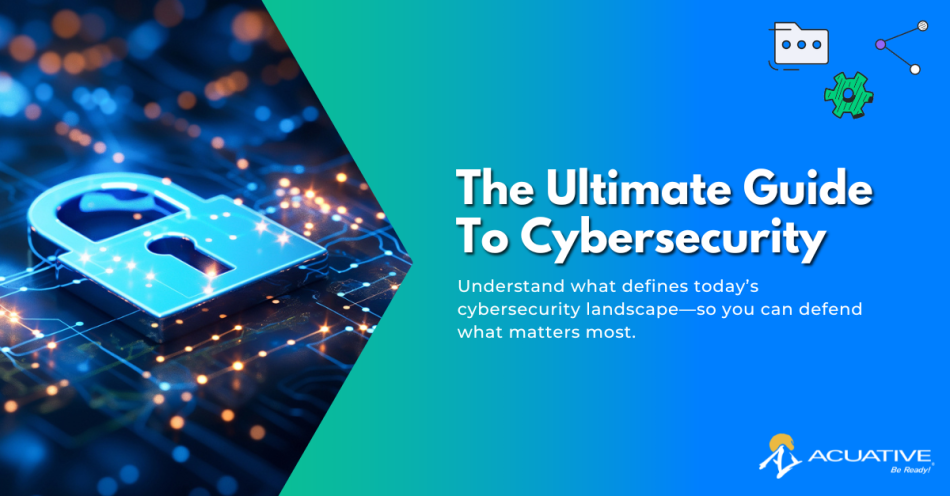Bennett Ruiz
In early 2025, the world watched as a sophisticated cyber campaign known as Salt Typhoon targeted telecommunications infrastructure and government systems across North America and Europe. This state-sponsored attack leveraged a blend of social engineering, zero-day exploits, and living-off-the-land techniques to infiltrate systems and exfiltrate sensitive data—without triggering conventional defenses.
Salt Typhoon is a stark reminder: understanding cybersecurity terminology isn’t about memorizing definitions—it’s about making better architectural, operational, and strategic decisions. Whether you’re a CIO, network architect, or IT service provider, these terms form the foundation of a resilient security posture.
This guide highlights the most important terms in today’s threat landscape, providing the context needed to apply them across enterprise IT environments, managed services, and modern threat models.
1. Firewall (FW)
Definition: A firewall is a device or software that monitors and controls incoming and outgoing network traffic based on predefined security rules. It can be configured to filter traffic based on IP addresses, domain names, protocols, and port numbers.
Technologies:
- Stateful Inspection: A method that tracks the state of active connections and makes decisions based on the context of the traffic.
- Application Layer Filtering: This allows firewalls to inspect traffic at the application layer and block specific types of data, like HTTP requests.
Use Case:
Firewalls are essential in securing perimeter networks. For example, in an enterprise setting, a Next-Generation Firewall (NGFW) might integrate additional security features like Deep Packet Inspection (DPI), Application Control, and Intrusion Prevention Systems (IPS) to block sophisticated threats such as Advanced Persistent Threats (APT).
2. Phishing
Definition: Phishing attacks attempt to deceive individuals into revealing sensitive information by masquerading as trustworthy sources. This is done via email, fake websites, or even phone calls.
Technologies:
- Anti-Phishing Tools: Use machine learning algorithms to detect suspicious emails and prevent them from reaching inboxes.
- DMARC (Domain-based Message Authentication, Reporting & Conformance): A security protocol that helps prevent phishing by verifying the legitimacy of an email’s origin.
Use Case:
Phishing remains a primary vector for data breaches. Organizations use email filtering solutions and anti-phishing training to reduce risk. For instance, AI-Driven Email Security can analyze sender behavior patterns to flag spoofed messages and phishing attempts.
3. Ransomware
Definition: Ransomware is a form of malware that encrypts a victim's data, rendering it inaccessible until a ransom is paid, usually in cryptocurrency. It's often delivered through phishing emails or vulnerable applications.
Technologies:
- Fileless Malware Detection: Tools that identify ransomware that operates without leaving traces on the disk.
- Immutable Backups: Backups that cannot be altered or deleted, ensuring data is recoverable even after an attack.
Use Case:
For a law firm, ransomware attacks can lock critical client data. Endpoint Detection and Response (EDR) solutions are employed to monitor unusual activity, while Automated Backup Solutions protect against data loss by regularly creating encrypted backups.
4. Endpoint Detection and Response (EDR)
Definition: EDR solutions provide continuous monitoring and real-time data collection from endpoints to detect, investigate, and respond to threats.
Technologies:
- Behavioral Analysis: Uses machine learning algorithms to monitor deviations from normal user or system behavior.
- Sandboxing: Involves isolating files and executables in a virtual environment to observe their behavior without risking the system.
- Extended Detection and Response (XDR): Integrates data from endpoints, networks, email, and cloud environments into a unified platform for cross-layered threat detection and automated response.
- Managed Detection and Response (MDR): Combines EDR/XDR tools with a team of cybersecurity experts who monitor, analyze, and respond to threats on behalf of the organization.
Use Case:
For an organization with remote workers, deploying EDR ensures that each endpoint is continuously monitored for suspicious activity. Advanced EDR platforms, like CrowdStrike Falcon or Carbon Black, provide threat intelligence integration and automated response capabilities.
XDR further enhances this capability by correlating telemetry across security layers—detecting complex attack chains that EDR alone might miss. For companies with lean internal security teams, MDR offers outsourced threat hunting and incident response, bridging the talent gap and improving response times.
5. Multi-Factor Authentication (MFA)
Definition: MFA requires users to authenticate their identity through two or more factors—something they know (password), something they have (smartphone), or something they are (biometric data).
Technologies:
- Time-Based One-Time Password (TOTP): A time-sensitive code sent to a mobile device or app like Google Authenticator.
- Push Notification MFA: A prompt is sent to a mobile device for user approval of the authentication request.
Use Case:
For a financial institution handling sensitive customer data, MFA is deployed to ensure that even if passwords are compromised, attackers cannot access critical systems without the second factor (e.g., a biometric scan or a TOTP from the mobile device).
6. Security Information and Event Management (SIEM)
Definition: SIEM solutions aggregate and analyze log data from various systems to provide real-time visibility into network activity and potential threats.
Technologies:
- Log Aggregation: Collects data from firewalls, servers, and endpoints.
- Threat Intelligence Feeds: Integrates external data sources to identify indicators of compromise (IOCs) and detect emerging threats.
Use Case:
A large-scale cloud provider uses a SIEM solution to monitor traffic between distributed systems. The integration of threat intelligence feeds allows the provider to automatically correlate network traffic patterns with known attack techniques like SQL injection or Cross-Site Scripting (XSS).
7. Virtual Private Network (VPN)
Definition: A VPN establishes a secure, encrypted tunnel between a user’s device and a private network over the internet, ensuring data confidentiality even on unsecured networks.
Technologies:
- IPsec (Internet Protocol Security): A suite of protocols that encrypt and authenticate data packets for secure VPN communication.
- SSL/TLS (Secure Sockets Layer/Transport Layer Security): Provides encryption for remote access VPNs, often used for securing web traffic.
Use Case:
Employees working remotely connect to corporate networks through SSL VPNs, which offer secure access to internal resources. IPsec VPNs are used for secure communication between office branches or between organizations and third-party vendors.
8. Zero Trust Architecture (ZTA)
Definition: Zero Trust assumes that no device or user, whether inside or outside the network, is trustworthy by default. Access is granted only after rigorous verification, including continuous authentication.
Technologies:
- Identity and Access Management (IAM): Tools that control user access based on roles, identity, and behavior.
- Micro-Segmentation: Divides networks into smaller, isolated segments to limit lateral movement in case of a breach.
Use Case:
A tech company adopts Zero Trust to ensure that employees must verify their identity and device status before accessing sensitive data. Micro-segmentation helps further reduce exposure by limiting the scope of access even within internal networks.
9. Intrusion Detection and Prevention System (IDS/IPS)
Definition: IDS systems monitor network traffic for suspicious activities, while IPS systems actively block malicious traffic based on predefined security rules.
Technologies:
- Signature-Based Detection: Uses a database of known threat signatures to identify attacks.
- Anomaly-Based Detection: Detects deviations from normal behavior, which is especially useful for detecting Zero-Day Exploits.
Use Case:
An e-commerce platform employs an IPS to block malicious traffic trying to exploit vulnerabilities in its web application. The system can identify and prevent SQL injection attacks, which are a common vulnerability in web applications.
10. Vulnerability Management
Definition: The process of identifying, assessing, prioritizing, and remediating vulnerabilities within a network or system to reduce security risks.
Technologies:
- Vulnerability Scanners: Tools like Nessus or OpenVAS that automatically identify software vulnerabilities.
- Patch Management Solutions: Systems that ensure vulnerabilities are patched as soon as updates are available.
Use Case:
A software company regularly scans its servers and workstations with vulnerability scanners and applies patches automatically using a Patch Management System (PMS). This proactive approach helps the company address vulnerabilities like Heartbleed or Shellshock before they can be exploited.
11. Distributed Denial of Service (DDoS) Attack
Definition: A DDoS attack overwhelms a target system by flooding it with traffic from multiple compromised sources, often through a botnet.
Technologies:
- Traffic Scrubbing Services: Cloud-based solutions that filter out malicious traffic before it reaches the target.
- Rate Limiting: Restricts the amount of incoming traffic to prevent service disruption during an attack.
Use Case:
For a gaming company, a DDoS attack could disrupt online gameplay, causing user frustration and financial loss. By leveraging cloud-based DDoS mitigation services like Cloudflare or AWS Shield, the company can absorb malicious traffic and ensure uninterrupted service during peak gaming hours.
12. Threat Intelligence (TI)
Definition: Threat intelligence is the process of gathering, analyzing, and applying information about potential or existing cyber threats. It enables businesses to proactively protect their assets and respond to emerging risks.
Technologies:
- Threat Intelligence Platforms (TIPs): Tools that aggregate and analyze threat data from multiple sources, such as open-source intelligence (OSINT) and commercial threat feeds.
- Threat Intelligence Sharing: Sharing information about threats between organizations and industry groups to improve collective defense.
Use Case:
A financial services firm uses a Threat Intelligence Platform to track emerging APT groups targeting its sector. By integrating the threat data into its SIEM and SOAR (Security Orchestration, Automation, and Response) system, it can automate threat detection and incident response.
13. Cloud Security Posture Management (CSPM)
Definition: CSPM tools continuously monitor cloud environments for misconfigurations, ensuring they comply with industry standards and best practices.
Technologies:
- Cloud Access Security Brokers (CASB): Tools that enforce security policies on cloud services.
- Automated Remediation: Tools that automatically fix misconfigurations or enforce security best practices.
Use Case:
For a SaaS provider operating in multi-cloud environments, CSPM tools help maintain a strong security posture by identifying and remediating misconfigurations in cloud storage buckets, access controls, and IAM roles.
Securing Your Future with Acuative
The cybersecurity landscape is vast, and the terms used to describe various technologies and practices are crucial for creating a comprehensive defense strategy. By understanding these advanced concepts and technologies, businesses can better assess their risk exposure and take proactive steps to protect their data, assets, and reputation.
The key takeaway from Salt Typhoon isn’t fear—it’s preparedness. Knowing the language of cybersecurity helps organizations better assess their exposure, make smarter investments, and collaborate more effectively with internal teams and external partners.
At Acuative, we specialize in delivering advanced, scalable cybersecurity solutions tailored to the real-world challenges facing enterprises today. Whether you're enhancing endpoint security, evaluating cloud posture, or building a Zero Trust strategy, our experts are here to help.
Let’s build a more secure tomorrow—together.
About Bennett Ruiz
With over 20 years of experience, Bennett Ruiz is a seasoned executive with a strong background in Telecom, Mobility, Marketing, and Advertising. His expertise spans sales, go-to-market strategy, CRM, digital marketing, and professional services. He has successfully led business development and strategic initiatives across global markets. A graduate of Harvard University and the Advanced Management Program at IESE Business School – University of Navarra, he is known for driving growth and innovation, and bringing a results-oriented approach to every challenge.

